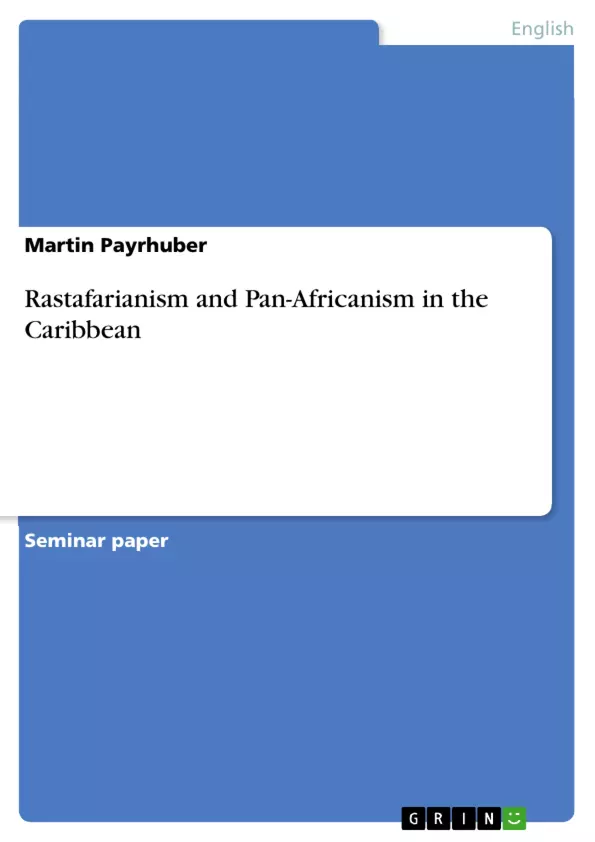Writing a paper that is called “Rastafarianism And Pan-Africanism In The Caribbean” represents a great challenge to me. The two terms “Rastafarianism” and “Pan-Africanism” are widely unknown among Central Europeans and especially among native German speakers, and I had been no exception before I dealt extensively with this topic. Therefore, although this is a literary term paper, I will present historical, religious and sociological facts along with linguistic annotations as a basic background to my literary studies in order to inform the reader and give him a more or less detailed survey ON Rastafarian culture and society. I regard it as necessary to give short definitions of Rastafarianism and Pan-Africanism and their relations to one another in the beginning, for the simple reason that many readers will hardly ever have come across these two terms before, but I will keep them short, because everything will be discussed in detail further on, at the examples of literary texts. These literary texts will comprise mainly songs, because the main possibility of expression for Rastafarian spokesmen is their music – Reggae.
Inhaltsverzeichnis (Table of Contents)
- Introduction
- Definition of Terms
- Pan-Africanism
- Rastafarianism
- Historical Framework
- Bible and Rebellion Among Slaves
- Ethiopism, Pan-Africanism and the Awakening of the Rastafari Religion
- Marcus Garvey and his Vision
- Haile Selassie
- Phenomenology of the Rastafari Religion
- Dealing with the Bible
- The Rastafari Idea of God
- The Name \"Jah❞
- God In Us: \"I - nity\"
- The Living God Haile Selassie
- The Rastafari Culture
- Rastafari Language
- Exterior Signs of Rastafarian Culture
- The Mystical Herb Ganja
- Conclusion from a Christian Point of View
Zielsetzung und Themenschwerpunkte (Objectives and Key Themes)
This paper aims to introduce readers to the often-overlooked concepts of Rastafarianism and Pan-Africanism, particularly within the Caribbean context. By exploring the historical, religious, and sociological aspects of these movements, the author seeks to provide a comprehensive understanding of Rastafarian culture and society. Through the analysis of literary texts, primarily Reggae music, the paper examines the evolution and expressions of these ideologies.
- The historical development of Rastafarianism and its roots in African traditions, the Bible, and the struggle against colonialism.
- The core beliefs and practices of Rastafarianism, including their understanding of God, the role of Haile Selassie, and the significance of the mystical herb Ganja.
- The intersection of Rastafarianism and Pan-Africanism, exploring the shared ideals of racial solidarity, liberation, and the return to Africa.
- The cultural expressions of Rastafarianism, including their language, music, and artistic practices.
- The impact of Rastafarianism on Caribbean society and culture, particularly in Jamaica.
Zusammenfassung der Kapitel (Chapter Summaries)
The paper begins by providing clear definitions of Pan-Africanism and Rastafarianism, highlighting the shared values of racial solidarity and cultural unity. The historical framework explores the influence of the Bible and the rebellion among slaves in shaping the religious landscape of the Caribbean, emphasizing the role of Baptist missionaries in promoting both Christianity and social emancipation.
The paper then delves into the phenomenology of the Rastafari religion, examining their unique interpretations of the Bible, their concept of God, and their reverence for Haile Selassie as the living God. The chapter also explores the various cultural aspects of Rastafarianism, including their language, exterior signs, and the significance of Ganja in their religious practices.
Schlüsselwörter (Keywords)
Rastafarianism, Pan-Africanism, Caribbean, Reggae music, Haile Selassie, Ethiopia, Jamaica, African diaspora, colonialism, liberation, cultural identity, religious beliefs, social movements.
- Quote paper
- Martin Payrhuber (Author), 1998, Rastafarianism and Pan-Africanism in the Caribbean, Munich, GRIN Verlag, https://www.grin.com/document/190669



